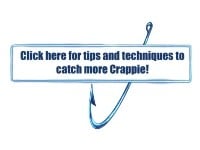Is it too hot to go crappie fishing? No way, but a number of anglers have shifted gears and switched over to trolling for crappie with crankbaits. However, there is more than one way to trolling crankbaits to catch crappie.
“It’s like money in the bank,” Mitch Glenn the owner of PICO Lures went on, “Once the lake heats up and you have a thermocline setup its prime time for trolling crankbaits. The best part is that you can troll for crappie here in the Ozarks all the way through the late fall and still catch limits of crappie every time out.”
Trolling crankbaits is a generic term, but normally used to describe when an angler is pushing or pulling a crankbait fast enough for it to dive under the surface. The length and angle of a crankbait’s lip decides just how deep a crankbait can possibly reach. That’s important to know as most crappie will be located in or above the thermocline in most reservoirs during the hot summer months or until the thermocline dissipates in the fall.
A simple rule for knowing how deep a crankbait is going to dive is to look at its bill. In general a longer, less angled lipped bill is going to dive to deeper depths than bills that are short with sharp angled lips. Although crankbait manufactures have explored multiple different lip configurations and added weight to the lip to increase the depth crankbaits will dive.
“PICO Lures Crankbaits come in two sizes,” Glenn went on, “You can cover any depth with them. A PICO squarebill will dive down to 5 feet and the PICO INT deep diver in the right conditions will go down to 18- to 20-feet. That pretty much covers where you are going to catch a crappie.” Glenn also noted that anglers can add a PICO Trolling Weight then a 3-foot leader to a PICO squarebill to get it to dive to deeper depths.
Crankbaits bodies are designed to run nose down or horizontal when pulled under the surface. Typically a nose down crankbait will dive deeper than a crankbait that dives, but runs horizontal.
Line size also plays a major part in how deep a crankbait will dive. Some fishing lines are extremely buoyant while others have smaller diameter’s, but have a stronger tensile strength. Smaller diameter fishing line will dive deeper than larger; however, monofilament line itself is buoyant compared to other fishing line.
Because monofilament line is buoyant that creates a bow in the line down to the crankbait being trolled. So an angler will have to take out the bow when setting the hook on a crappie with monofilament. There will be less of a bow above the water if an angler is trolling with Offshore Tackle Planer Boards since they are attached at the surface of the water or B’n’M Poles Pro Staff Rods with rod tips pointed and tipped towards the surface.
Glenn likes to use PICO Lures Vanguard Tackle Forcefiber Braid in 30-pound test/ 8-pound diameter with just a snap tied to the end of the line and connected directly to the crankbait. Another option is Varivas braided fishing line. Varivas PE polyethylene fishing line with its non-stretching strengths allow anglers to see their crankbaits wobbling when trolled or see a strike easily. It’s 2.5- to 3-times stronger than similar diameter sized nylon line.
Besides fishing line the other two factors on how deep a crankbait dives is trolling speed and length of fishing line out. Trolling speeds once above 1.5mph will not change the diving depths of a crankbait. So you should set speed by how active a crappie is and how fast to get a crappie to bite.
How much line you have let off your reel will dictate how deep your crankbait is diving. In general the more line the deeper the crankbait will go. Precision Trolling Data Inc. is a website that has most crankbait diving depths for anglers wanting more information on how deep crankbaits dive.
One other action to figure into what crankbait you use is the wobble. Normally a wide lipped and round shaped body style is likely to have a wide, pronounced wobbling action. Unlike a slender lipped, thin bodied crankbait that will have a tight tail wobbling action. When it comes to trolling crankbaits for crappie in the warmer months typically the wider wobbling action like a PICO crankbait is preferred.
“One thing that is unique to PICO Lures crankbaits is the body shape,” Glenn continued, “PICO crankbaits have dimples on their bodies unlike other crankbaits. These dimples reflect light as they wobble being pulled making it easier for crappie to see the numerous color patterns we have at any angle.”




 Articles and Stories
Articles and Stories

















vBulletin Message